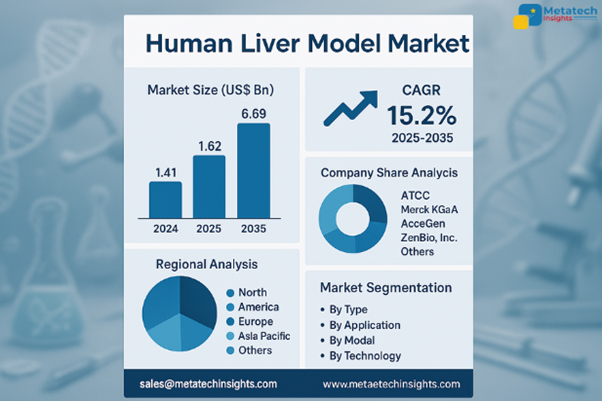Global Human Liver Model Market to Hit USD 6.69 Bn by 2035 | CAGR 15.2%
23 Aug 2025 | Report ID: MI3423 | Industry: Healthcare | Pages: 217 | Forecast Year: 2025-2035

Read more about this report- Global Human Liver Model Market to Hit USD 6.69 Bn by 2035 | CAGR 15.2%
- The Human Liver Model Market is valued at USD 1.41 billion in 2024.
- The Human Liver Model Market will achieve USD 6.69 billion by 2035 through a projected 15.2% CAGR from 2025 to 2035.
- The Human Liver Model Market is undergoing massive growth as research in drug development, disease research, and toxicity experiments necessitates improved in vitro models. Increased awareness of liver diseases and promotion of alternative testing methods by the regulatory bodies, and the popularity of precision medicine are market leaders. Advances in the accuracy and reproducibility of models, and in their compatibility with high-throughput screenings, are also contributing to their use in more research institutions and within pharmaceutical companies.
- Market segmentation is conducted based on type, application, model, and technology. By type, 3D liver spheroids, organoids, and liver-on-chip models will be part of the market; 3D liver spheroids continue to capture a notable market share because of their physiological condition and ease of use in a drug screening process. Application-wise, drug discovery, disease modeling, toxicity testing, and personalized medicine are the segments, with drug discovery being the most dominant as the demand for predictive models of preclinical studies increases.
- By model, models are categorized into primary hepatocytes, stem cell-derived hepatocytes, and immortalized cell lines, with stem cell-derived models being in demand due to their scalability and relevance to the human condition. The market, as technology defines it, includes microfluidics, bioprinting, and scaffold-based systems; however, microfluidic liver-on-chip platforms are a fast-growing part of the market because of dynamic modeling of hepatic microenvironments.
- The end-users are the pharmaceutical and biotechnology firms, academic and research institutions, and contract research organizations (CROs). Drug safety and drug efficacy testing are the major areas of adoption by pharmaceutical companies, with academic and research institutions using these models to carry out mechanistic studies and disease modeling. CROs are gaining popularity in offering human liver models as a new line of services driven by client demands in favor of predictive in vitro testing.
- The rise in the market is also facilitated by the development of tissue engineering, a rise in research funding on liver diseases, and the trend toward the use of ethically acceptable alternatives to animal testing. In addition, the increased reproducibility, high-throughput compatible models, and integration with AI-driven analytics are of interest to researchers all over the world.
- Geographically, geographical coverage is across North America, Europe, Asia Pacific, Latin America, and the Middle East & Africa. The largest share is attributed to North America, whose pharmaceutical infrastructure is well established and allocates significant funds to research and technological innovations. It is expected that the Asia Pacific will be the fastest-growing region as a result of growing investments in biotechnology, growing research on healthcare, and rising awareness of advanced liver models.
- Some of the players in the Human Liver Model Market that are key to shaping it are HeartCyte Biotechnologies, LLC, ATCC, Merck KGaA, AcceGen, and ZenBio, Inc. The development of high-fidelity and reproducible models, strategic launching of products, and multi-channel distribution networks are the current concerns of these companies to keep up with the emerging needs of pharmaceutical and academic research.
Maximize your value and knowledge with our 5 Reports-in-1 Bundle - over 40% off!
Our analysts are ready to help you immediately.
